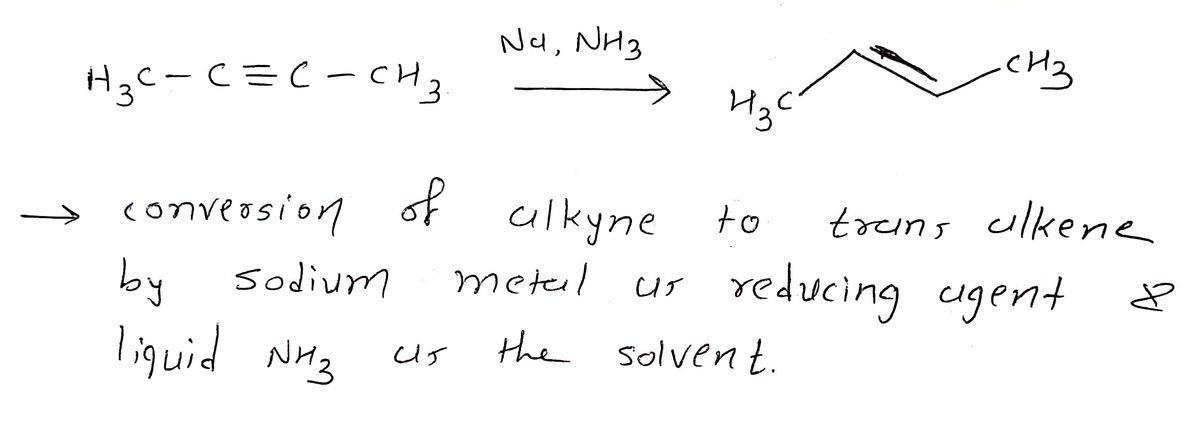H3C-C=C-CH3 Arrow-pushing Instructions H3C Alkynes are reduced to trans alkenes by a process called dissolving metal reduction. The reaction uses sodium or lithium metal as the reducing agent and liquid ammonia as the solvent. The method is specific in the formation of trans alkenes from alkynes. The method involves two successive transfers of single electrons from the alkali metal to the triple bond, with abstraction of protons from the ammonia solvent. Draw curved arrows to show the movement of electrons in this step of the mechanism. NOC XT H3C Na, NH3 CH3 HÌNH, H3C CH3 H CH3 NH₂
H3C-C=C-CH3 Arrow-pushing Instructions H3C Alkynes are reduced to trans alkenes by a process called dissolving metal reduction. The reaction uses sodium or lithium metal as the reducing agent and liquid ammonia as the solvent. The method is specific in the formation of trans alkenes from alkynes. The method involves two successive transfers of single electrons from the alkali metal to the triple bond, with abstraction of protons from the ammonia solvent. Draw curved arrows to show the movement of electrons in this step of the mechanism. NOC XT H3C Na, NH3 CH3 HÌNH, H3C CH3 H CH3 NH₂
Chemistry
10th Edition
ISBN:9781305957404
Author:Steven S. Zumdahl, Susan A. Zumdahl, Donald J. DeCoste
Publisher:Steven S. Zumdahl, Susan A. Zumdahl, Donald J. DeCoste
Chapter1: Chemical Foundations
Section: Chapter Questions
Problem 1RQ: Define and explain the differences between the following terms. a. law and theory b. theory and...
Related questions
Question
Please depict whether the arrow indicates a change in 1 electron or an electron pair!

Transcribed Image Text:H3C-C=C-CH3
NOC XT
H3C
H3C
Alkynes are reduced to trans alkenes by a process called dissolving metal reduction. The reaction uses sodium or
lithium metal as the reducing agent and liquid ammonia as the solvent. The method is specific in the formation of
trans alkenes from alkynes. The method involves two successive transfers of single electrons from the alkali metal
to the triple bond, with abstraction of protons from the ammonia solvent.
Draw curved arrows to show the movement of electrons in this step of the mechanism.
Arrow-pushing Instructions
Submit Answer
CH3
HÌNH,
Na, NH3
Retry Entire Group
H3C
9 more group attempts remaining
CH3
H
CH3 NH₂

Transcribed Image Text:H3C-C=C-CH3
07
H3C
Alkynes are reduced to trans alkenes by a process called dissolving metal reduction. The reaction uses sodium or
lithium metal as the reducing agent and liquid ammonia as the solvent. The method is specific in the formation of
trans alkenes from alkynes. The method involves two successive transfers of single electrons from the alkali metal
to the triple bond, with abstraction of protons from the ammonia solvent.
Draw curved arrows to show the movement of electrons in this step of the mechanism.
Arrow-pushing Instructions
Na.
H3C
→XT
Submit Answer
CH3
Na, NH3
Retry Entire Group
H3C
C CH3
9 more group attempts remaining
CH3
Na+
Expert Solution
Step 1

Step by step
Solved in 2 steps with 2 images

Knowledge Booster
Learn more about
Need a deep-dive on the concept behind this application? Look no further. Learn more about this topic, chemistry and related others by exploring similar questions and additional content below.Recommended textbooks for you

Chemistry
Chemistry
ISBN:
9781305957404
Author:
Steven S. Zumdahl, Susan A. Zumdahl, Donald J. DeCoste
Publisher:
Cengage Learning

Chemistry
Chemistry
ISBN:
9781259911156
Author:
Raymond Chang Dr., Jason Overby Professor
Publisher:
McGraw-Hill Education

Principles of Instrumental Analysis
Chemistry
ISBN:
9781305577213
Author:
Douglas A. Skoog, F. James Holler, Stanley R. Crouch
Publisher:
Cengage Learning

Chemistry
Chemistry
ISBN:
9781305957404
Author:
Steven S. Zumdahl, Susan A. Zumdahl, Donald J. DeCoste
Publisher:
Cengage Learning

Chemistry
Chemistry
ISBN:
9781259911156
Author:
Raymond Chang Dr., Jason Overby Professor
Publisher:
McGraw-Hill Education

Principles of Instrumental Analysis
Chemistry
ISBN:
9781305577213
Author:
Douglas A. Skoog, F. James Holler, Stanley R. Crouch
Publisher:
Cengage Learning

Organic Chemistry
Chemistry
ISBN:
9780078021558
Author:
Janice Gorzynski Smith Dr.
Publisher:
McGraw-Hill Education

Chemistry: Principles and Reactions
Chemistry
ISBN:
9781305079373
Author:
William L. Masterton, Cecile N. Hurley
Publisher:
Cengage Learning

Elementary Principles of Chemical Processes, Bind…
Chemistry
ISBN:
9781118431221
Author:
Richard M. Felder, Ronald W. Rousseau, Lisa G. Bullard
Publisher:
WILEY